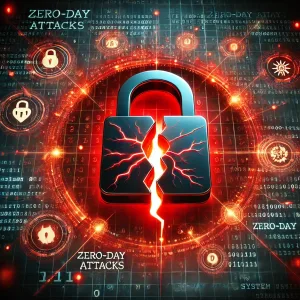What is Zero Day Attack

Introduction to Zero Day Attack
In today’s fast growing cybersecurity world, zero day attack have been noticed to be one of the most dangerous and covert threats. These attacks exploit vulnerabilities which are unknown to software development companies and general public. Due to these vulnerabilities computer systems are vulnerable until they are fixed by the software companies. These attacks come as a surprise to the victim due to which their impact is immense. That is why zero day attack is considered to be a major concern for today’s corporate culture, governments, and individuals. In this article, I will explore the mechanism of a zero day attack, highlight some of the real world cases, discuss the challenges, and will also explain some steps for protection.
Why is it Called “Zero Day Attack”?
A zero day attack is carried out when hackers exploit a vulnerability in a software before the developers or users identifies it and fixes it. The term “zero day” means that vendors had zero days to patch the vulnerability before it was exploited by the cybercriminals. Since these vulnerabilities are unknown before the attack; therefore, defense against such attacks is incredibly difficult.
Characteristics of Zero Day Attack:
Unknown Vulnerabilities:
A Zero Day Attack targets the vulnerabilities which are previously unknown to developers and security experts.
Prompt Exploitation:
As the name of the attack suggests, the idea is to exploit the vulnerability before it is identified and patched. Therefore, hackers attack quickly to exploit these vulnerabilities.
Likelihood of Severe Damage:
Since a Zero Day Attack is unforeseen therefore, it is difficult to anticipate it. That is why a Zero Day Attack is considered to be more lethal. Resultantly it may cause theft of sensitive data, heavy financial losses, and unauthorized access to the system.
For further detailed article on emerging cyber threats, please visit Top 10 Cybercrime Cases of 2024.
Stages of a Zero Day Attack
The lifecycle of a zero day attack can be divided into several stages:
- Identification of Vulnerability: First stage to carry out a zero day attack is identification of the vulnerability in a software, hardware, or firmware by the cybercriminals. Cybercriminals use insider information and carry out intensive testing to validate the identified vulnerability.
- Development of Code to Exploit: After the vulnerability is found, second stage is to generate a code which can exploit it. At this stage attackers have two options; either to use the exploit for himself or to sell it on the dark web.
- Attack Deployment: If the attackers decide to use the exploit himself, he will launch the attack by delivering the code which was developed in stage 2. The attackers can deliver it through different means, like phishing emails, already compromised files, or malicious websites.
- Impact Realization: As I have discussed above that it is difficult to apprehend a Zero Day Attack. Therefore, it is only realized that the system has been compromised due to its impact. Impact that can be realized as a result of a zero day attack is unauthorized access, data breach, service disruption, or even espionage.
- Discovery and Remediation: Once the attack is identified due to its impacts, then the vendors and cybersecurity experts start their work to develop the patch for this exploit.
For detailed coverage of phishing techniques, check out Why Online Scams Are on the Rise.
Famous Examples of a Zero Day Attack
Microsoft Exchange Server Breach (2021):
In 2021 cybercriminals exploited some vulnerabilities in Microsoft Exchange and launched a zero day attack. This attack affected different organizations around the world which were using Microsoft Exchange Server, and exposed their critical information.
Pegasus Spyware (2021-2023)
Pegasus is a spyware which was developed by NSO Group in 2021. Through 2021 till 2023, they distiributed it across a number of mobile devices running on iOS and Android. This spyware exploited zero day vulnerabilities in compromised devices. The group used this spyware to monitor journalists, activists, and political figures around the world.
Log4Shell Zero Day Attack (2021)
This is considered to be one of the most critical zero day attack. To carry out this attack, the cybercriminals targeted the open source library Log4j. Through this library attackers remotely executed random codes. This vulnerability affected a number of different global applications and services, including Amazon, Microsoft, and IBM.
Zimbra Email Server Attack (2022)
Attackers successfully identified multiple zero day vulnerabilities in Zimbra email servers. Using those vulnerabilities, cybercriminals targeted government agencies and businesses. These types of breaches highlight the risks which are associated with critical communication tools.
MOVEit Transfer Vulnerability (2023)
The MOVEit Transfer zero day attack was carried out by exploiting the vulnerability which was then unknown to the company. As a result of this attack the cybercriminals run a ransomware campaign that affected different organizations due to exposure of their sensitive customer data and disruption of services. To read more about it you can visit my earlier blog Top 10 Cybercrime Cases.
WinRAR Archive Vulnerability (2023)
In 2023 cybercriminals discovered a zero day vulnerability in WinRAR’s compression software. They used it to deliver malware to such users who opened malicious archives. This attack highlighted risks even in everyday utilities softwares.
Google Chrome Zero-Day (2023)
A series of zero day vulnerabilities were discovered and patched in Google Chrome, affecting its WebRTC and GPU libraries.
Adobe Acrobat Reader Exploit (2024)
Attackers identified and used a zero day vulnerability in Adobe Acrobat Reader to target businesses and government entities. Attackers delivered manipulated PDF files to the users and gained remote access to their systems.
SolarWinds Orion (2024)
New zero day vulnerabilities were discovered in the SolarWinds Orion software in 2024. This led to new forms of attacks on IT management infrastructure. It has badly affected global enterprises and certain critical industries.
WhatsApp Zero Day Attack (2024)
WhatsApp claims to be end to end encrypted communication. However in 20204, attackers carried out a zero day attack on WhatsApp voice calling feature. Attackers utilized this vulnerability to deploy the spyware on compromised devices.
OpenAI API Attack (2024)
In a recent incident, a zero day attack has been identified in an AI software which is mostly relied upon for use of AI. Using this vulnerability, the attackers exploited this vulnerability and stole prompts and API tokens of the users. Due to this incident security and data privacy of world’s leading AI driven systems has also being questioned.
These examples highlight the exixsting and upcoming nature of zero day attack. It is therefore important to take proactive cybersecurity measures and regular vigilance, so that the risk of becoming a victim can be minimized.
You can also read about other high profile cyber incidents on Hackers Force Chrome Users to Hand Over Google Passwords.
Challenges in Anticipating Zero Day Attack

1. Unpredictability:
Since a Zero day attack exploits an unknown vulnerability in a software or firmware, therefore, it is difficult to anticipate and detect.
2. Sophistication:
Cybercriminals are very well aware of the existing cybersecurity techniques. Therefore, they launch these attacks using advanced techniques which can bypass traditional cybersecurity infrastructure.
3. Time Constraints:
Zero day attack is launched before the vulnerability is known to the vendor or cybersecurity team. Therefore attackers exploits the flaw very quickly. Resultantly vendors have very little time to issue patches.
Strategies for Mitigation Zero Day Attack
I will not be wrong to say that complete prevention of zero day attack is almost impossible. However, organizations can adopt following proactive measures to reduce risks:
- Layered Security Measures: Multiple layers of defense, such as intrusion detection/prevention systems, end to end encryption, and firewalls, can be used to make the system more secure.
- Regular Updation of Software: Routine updates rolled by software vendors are very helpful to patch the vulnerabilities in the software. Therefore, always keep all software up to date so that the known vulnerabilities can be patched which may avoid a zero day attack.
- Anomaly Detection Tools: There are certain tools which can identify any unusual behavior in the system. Detection of any unusual behavior can avoid a zero day attack.
- Segmented Networks: Despite of putting all of your apples in one basket you should segment it. Similarly large networks should also be divided into smaller, isolated segments. This will at least keep other networks safe even in case of breach of one of the networks.
- Threat Intelligence Sharing: There are online forums where latest threats are shared among the community. You should also engage yourself with threat intelligence platforms to know about emerging risks.
- Employee Awareness Programs: Train employees to identify and report phishing attempts and other forms of cyberattacks.
For an overview of essential cybersecurity tools, see How Interpol Adapts to Evolving Cybercrime Threats.
Conclusion
Zero day attack highlights the upcoming threats for today’s modern digital world. By understanding how these attacks work and by adopting proactive measures, we can strengthen our digital infrastucture against these unforeseeable threats. Collaboration, vigilance, and innovation is very important to counter upcoming zero day attack.
To keep yourself updated on the latest in cybersecurity and digital forensics keep visiting www.naumanbodla.com. We can together move forward to mitigate the complexities of the cyber threats.



